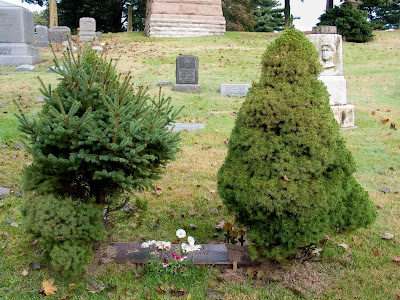
The tree on the right is a dwarf Alberta spruce. It's a popular landscape planting because it grows slowly and retains its conical shape without any pruning. The tree on the left is also a dwarf Alberta spruce, but it's sporting.

The dwarf Alberta spruce, discovered in 1904 near Lake Laggan in Alberta, Canada, is cultivar of white spruce,
Picea glauca. Cultivars are prone to bud sporting, a phenomenon in which a branch reverts, or mutates back, to the original species. This bud sport, if left to grow, will dominate the dwarf Alberta spruce, as white spruce grows much faster.

White spruce has thicker needles with a slight bluish tinge.

Dwarf Alberta spruce rarely fruits, but the white spruce sport has lots of cones.
 The tree on the right is a dwarf Alberta spruce. It's a popular landscape planting because it grows slowly and retains its conical shape without any pruning. The tree on the left is also a dwarf Alberta spruce, but it's sporting.
The tree on the right is a dwarf Alberta spruce. It's a popular landscape planting because it grows slowly and retains its conical shape without any pruning. The tree on the left is also a dwarf Alberta spruce, but it's sporting. The dwarf Alberta spruce, discovered in 1904 near Lake Laggan in Alberta, Canada, is cultivar of white spruce, Picea glauca. Cultivars are prone to bud sporting, a phenomenon in which a branch reverts, or mutates back, to the original species. This bud sport, if left to grow, will dominate the dwarf Alberta spruce, as white spruce grows much faster.
The dwarf Alberta spruce, discovered in 1904 near Lake Laggan in Alberta, Canada, is cultivar of white spruce, Picea glauca. Cultivars are prone to bud sporting, a phenomenon in which a branch reverts, or mutates back, to the original species. This bud sport, if left to grow, will dominate the dwarf Alberta spruce, as white spruce grows much faster. White spruce has thicker needles with a slight bluish tinge.
White spruce has thicker needles with a slight bluish tinge.  Dwarf Alberta spruce rarely fruits, but the white spruce sport has lots of cones.
Dwarf Alberta spruce rarely fruits, but the white spruce sport has lots of cones.

Thanks for the images. I suspected that one of my Alberta Spruces was putting out a sport, but I didn't know any of the details, i.e., that white spruce is the underlying species. Anyway, I plan to prune out the reverting branch this spring.
ReplyDelete